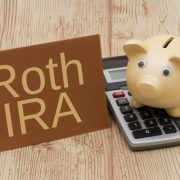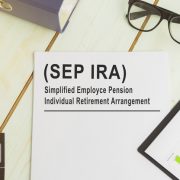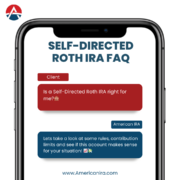Self-Directed Roth IRA Conversions
A qualified rollover contribution is one of the many ways in which a Self-Directed Roth IRA can be funded. With a qualified rollover contribution, assets are moved from a traditional retirement savings account to a Self-Directed Roth IRA. For the purpose of this overview, we will refer to qualified rollover contributions as Roth conversions.
A Roth conversion is a two-part transaction, with a distribution occurring on the traditional account side and a rollover occurring on the Self-Directed Roth IRA side.
This outline provides a high-level overview of Roth conversions.
Roth Conversion Defined
A Roth conversion occurs when amounts are moved from a traditional retirement account to a Self-Directed Roth IRA. The options for doing so are:
- A conversion of assets from a Traditional IRA, Self-Directed SEP IRA or Self-Directed SIMPLE IRA[1] to a Self-Directed Roth IRA.
- A rollover of assets from a traditional account under an employer sponsored retirement plan[2] to a Self-Directed Roth IRA.
In either case, the amount must first be eligible for rollover, in order to be converted to a Self-Directed Roth IRA.
Amounts that are not eligible for rollover, and therefore not eligible for a conversion include required minimum distributions (RMD)s and excess contributions. A Self-Directed Roth IRA owner should consult with his/her tax professional for assistance with determining whether an amount is eligible for rollover.
Roth Conversion Methods
A Roth conversion can be direct or indirect.
- With a direct conversion, the amount is paid by the delivering (non-Roth IRA) custodian/trustee to the receiving Self-Directed Roth IRA custodian/trustee, for the benefit of the Roth IRA owner; and is deposited directly to the Roth IRA. In some cases, the delivering and the receiving custodians/trustees are one and the same. There is no time limit for direct conversions.
- With an indirect conversion, the amount is paid to the Self-Directed Roth IRA owner, who then has 60 days from the date of receipt to deposit the amount to the Roth IRA.
Tax Treatment of Roth Conversions
Roth conversion amounts are treated as ordinary income for the year in which the distribution side occurs. For example, if a Self-Directed Roth IRA owner takes a distribution from a Traditional IRA in December 2018 and deposits the amount to a Roth in January 2019, the amount is treated as a 2018 Roth conversion; and reported on the individual’s 2018 tax return as ordinary income.
Withholding Rules for Roth Conversions
Because the delivering side of a Roth conversion is a distribution, it is subject to the same tax withholding rules that apply to distributions. These are as follows:
For Conversions from Traditional, Self-Directed SEP IRA and Self-Directed SIMPLE IRAs
- The IRA owner can choose to have 10% or more withheld for federal income tax.
- If no withholding tax election is made, the custodian must withhold 10% for federal income tax.
For Rollovers from Employer Sponsored Retirement Plans
- If the amount is processed as a direct rollover to the Self-Directed Roth IRA, then there is no tax withholding.
- If the amount is paid to the account owner, the payor must withhold 20% of any taxable amount for federal income tax. The account owner can elect to have more withheld.
Tax Reporting
There are two sets of tax reporting that must be done for Roth Conversions; tax reporting by the IRA custodian/plan trustee and tax reporting by the Self-Directed Roth IRA owner.
The IRA custodian/plan trustee must issue IRS Form 1099-R for the distribution side of the Roth conversion and IRS Form 5498 for the funds deposited to the Self-Directed Roth IRA.
The amount must be reported on the Self-Directed IRA owner’s tax return as ordinary income.
For employer sponsored retirement plans, the plan administrator is responsible for indicating the taxable amount on IRS Form 1099-R.
For Self-Directed IRA, the IRA owner’s tax preparer is responsible for determining how much of the converted amount is taxable.
Recharacterizations
A recharacterization is a reversal of a Roth conversion[3]. Any recharacterization must be made to a Traditional IRA, even if the conversion was made from an employer sponsored retirement plan.
Any conversion amount that is recharacterized must be accompanied by any net income attributable (NIA) to the amount. The NIA must be calculated using the IRS formula provided in IRS Publication 590-A (Worksheet 1-3).
A recharacterization must be completed by the Self-Directed IRA owner’s tax filing due date, plus extensions. An IRA owner who files his or her tax return by the due date, receives an automatic 6-month extension to complete a recharacterization.
Caution: Roth conversions done after December 31, 2017 are not permitted to be recharacterized[4]
A Roth conversion amount that is properly recharacterized reverses the tax effect of the Roth conversion, and restores the amount to the Traditional IRA.
Additional Information
Assets can also be converted from the traditional side to the Roth side of an employer sponsored retirement plan. This process is referred to as an in-plan conversion. The Roth side of these plans are referred to as designated Roth Accounts (DRA).
In-plan conversions may not be recharacterized.
Individuals should consult with their plan administrators for information about in-plan conversions.
Tax Advice
Individuals should consult with their tax advisors about whether to perform Roth conversions and recharacterizations.
Interested in learning more about Self-Directed IRAs? Contact American IRA, LLC at 866-7500-IRA (472) for a free consultation. Download our free guides or visit us online at www.AmericanIRA.com.
[1] An amount may be converted from a SIMPLE IRA to a Roth IRA, only if it has been at least 2-years since the first SIMPLE contribution was made to the SIMPLE IRA
[2] Qualified plan, such as a 401(k) or pension plan, 403(b) and governmental 457(b)
[3] A recharacterization can also be used to change a regular traditional IRA contribution to a regular Roth IRA contribution and vice versa
[4] Repealed under the Tax Cuts and Jobs Act (Pub. L. No. 115-97)






